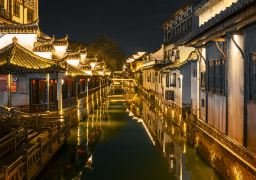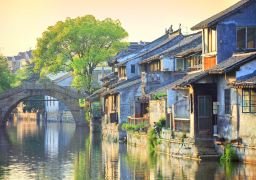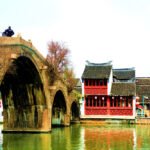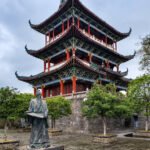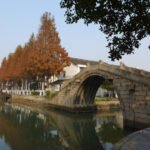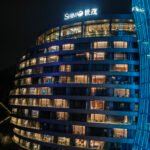Fengjing Ancient Town is located in the southwest corner of Shanghai and is a typical water town in the south of the Yangtze River. As early as more than 2,000 years ago, people lived in Fengjing Ancient Town. The boundary river in the town was the boundary river between the State of Wu and the State of Yue in the Spring and Autumn Period. Due to spanning the two realms of Wu and Yue, Fengjing Ancient Town is known as ‘the famous town of Wu and Yue’. The ancient town has crisscrossing rivers and as many as 52 bridges. Among them, Zhihe Bridge built in the Yuan Dynasty has a history of nearly 700 years. Compared with other popular water towns in the south of the Yangtze River, Fengjing does not have so many tourists. You can leisurely enjoy the scenery of small bridges and flowing water here. The ancient town has two main streets. One is a street called South Street in the south section, Central Street in the middle section, and North Street in the north section (although there are three names for different sections, they are actually one continuous street). The other is Heping Street. The two streets intersect at Fengjing Three Bridges, forming a ‘T’ shape. Fengjing Three Bridges are the center of the ancient town. At the confluence of two rivers, you can see Qingfeng Bridge, Zhuhang Bridge, and Beifeng Bridge at the same time. Fengjing is the birthplace of Jinshan peasant paintings. You can enjoy paintings full of rural charm at the Jinshan Peasant Painting Exhibition Center in Shengtang Lane on South Street. There are many painting galleries and former residences of famous painters in the ancient town. In the Ding Cong Cartoon Exhibition Hall on North Street, there are furniture used by Mr. Ding. On the second floor, you can see satirical cartoons that vividly depict characters. In Lv Jiren’s Painting Gallery on Heping Street, you can see the paintings of Lv Jiren, a classmate of Chen Yifei. Cheng Shifa’s former residence has many Chinese watercolor paintings by Mr. Cheng. Generally, tourists enter from the main entrance in the south of the ancient town and walk to South Street. Then they start to slowly stroll around the ancient town along the river. Walking northeast from South Street and passing Zhihe Bridge, you will arrive at Central Street. At the beginning of Central Street, you can see the Wu-Yue boundary marker. There is a boundary stone erected. The inconspicuous small river in front is the former boundary between Wu and Yue. Continuing to walk northeast, passing Fengjing Three Bridges is North Street. On North Street, you can visit Shiwang Temple with red walls built in the Ming Dynasty and Ding Cong Cartoon Exhibition Hall. On South Street, Central Street, and North Street, you will also pass long corridors with roofed sheds. There are several such long corridors in the ancient town. They are antique. They can block the sun on sunny days and keep out the rain on rainy days. Treading on the bluestone road and returning to the place of Fengjing Three Bridges, then go to visit another street, Heping Street. First, visit Sanbai Garden (Hundred Basket Museum, Hundred Lamp Museum, Hundred Trades Museum). Next to it is Lv Jiren’s Painting Gallery. Walking a little southeast, the former site of the people’s commune is worth seeing. There are old-fashioned thermos flasks and telephones from that era. There is a red sun painted on the wall. Further ahead is the ancient Fengjing stage facing the street on one side and the river on the other. During tourist seasons and holidays, there are free traditional drama performances on the stage. Sitting in a window seat in Chenshe Teahouse opposite the stage, sipping tea and listening to the opera is very pleasant.
Follow the street to the end and visit the ancestral home of Cheng Shifa. Finally, cross the bridge to the production street on the other side of the river, where there is an old site of a modern fire-fighting institution – the East District Fire Policy Association. At the head of the South Street in Fengjing Ancient Town, there is a cruise dock where you can take a boat to experience the charm of a water town. The first recommendation for food in the ancient town is Ding’s pork trotters. There is a workshop for them next to Zhihe Bridge on South Street, where you can learn about the development and craftsmanship of Ding’s pork trotters in the ancient town. Close to Fengjing’s three bridges on the production street, there is a restaurant called ‘Wunao Wuli’ (a local dialect meaning ‘at home’), which is a good environment in the ancient town. Inside, there is a long skylight forming the appearance of a small bridge and flowing water. Snail stuffed with meat and Wu Yue tofu are their signature dishes. Along the river on the production street, shops are lined up selling Fengjing steamed dumplings and Euryale ferox cake, among which the smoked eel has a unique feature. It is known as ‘smoked toad’ in the local Shanghai dialect, which tastes very good, but you need to have the courage to taste it first. About 4 kilometers away from the ancient town, close to Zhonghong Road, there is a Chinese Peasant Painting Village, which is also quite distinctive and can be visited together with Fengjing Ancient Town. Opening hours: 05/01-09/30 from 08:00 to 17:00; 10/01-04/30 from 08:00 to 16:30. Parking services: Parking lot of Fengjing Ancient Town, reference price: large bus 15 yuan per time, small car 10 yuan per time; Address: No. 28, Lane 8588, Tingfeng Highway, Jinshan District, Shanghai; Number of parking spaces: 300. Luggage storage: reference price: free, deposit of 200 yuan required; Address: parking lot consultation center. Baby stroller rental: reference price: free, deposit of 200 yuan required; Address: parking lot consultation center. Nursing room: There is a nursing room at the Fengjing Ancient Town consultation center, which is available for free use by tourists.

